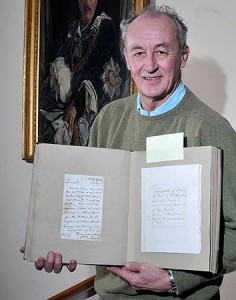 A letter written by Scottish poet Robert Burns to James Gregory, head of Edinburgh University’s medical school, has been discovered in the archives of Floors Castle in Kelso, in the eastern Scottish lowlands known as the Scottish Borders. The letter is dated May 13, 1789, and was discovered by a castle staffer in a 19th century autograph book that belonged to the sixth Duke of Roxburghe.
A letter written by Scottish poet Robert Burns to James Gregory, head of Edinburgh University’s medical school, has been discovered in the archives of Floors Castle in Kelso, in the eastern Scottish lowlands known as the Scottish Borders. The letter is dated May 13, 1789, and was discovered by a castle staffer in a 19th century autograph book that belonged to the sixth Duke of Roxburghe.
The discovery was announced just in time for Burns Night (January 25), when Scots everywhere come together to sup on sheep organs boiled in other sheep organs, quaff whisky, sing Burn’s songs and recite his poetry.
The current (tenth) Duke of Roxburghe, Guy Innes-Ker, notes that his ancestor was an avid collector of correspondence and autographs and that the book in which the Burns letter was found also contains an autograph from Charles Dickens. The book contains documents that date back to King Charles I (1600-1649), many of them family records.
The newly discovered letter includes an early draft of one of his most famous poems, “On Seeing a Wounded Hare,” which would be first printed 4 years after the letter. The draft includes a verse that Burns deleted in its entirety before printing, so the letter provides rare new insight into the evolution of the poem. The deleted fourth verse:
Perhaps a mother’s anguish adds its woe
The playful pair crowd fondly by thy side
Ah! helpless nurslings, who will now provide
That life a mother only can bestow!
The Floors Castle staff sent the letter to a variety of Burns experts to authenticate it. They all confirmed it was the real deal.
The document was eventually verified by Professor David Purdie, editor-in-chief of the Burns Encyclopaedia. [..]
Prof Purdie hailed the unearthing of the correspondence, describing it as a “remarkable discovery”.
He said: “Unpublished letters of Robert Burns are extremely rare and this example is doubly interesting as it not only displays the evolution of one of his poems, The Wounded Hare, published in the 1793 Edinburgh Edition of his Poems, but, in Burns and Gregory, it brings together major figures of both the literary and scientific components of the Enlightenment.
“This is the only letter that we know of from Burns to Gregory. Burns rated Gregory as a literary critic. They had met in Edinburgh at the dinner table of Lord Monboddo – one of the great law lords of the 18th century – and got on well.”
In the letter Burns is keen to hear Gregory’s opinion of his work, and tells him to “mark faulty lines with your pencil.” Apparently Gregory’s response was less than effusive in its praise as Burns would write to another friend that “Gregory is a good man, but he crucifies me!”
The poem was inspired by the unsporting shooting of a hare that Burns witnessed during his stay at Ellisland Farm in 1789. A farmer named Thomson shot a hare for gnawing on his father’s garden, wounding her, but not killing her. Burns was so furious about the shot that he threatened to throw Thomson in the river. He didn’t follow through on the threat, but he did fustigate him with blistering poesy.
Ellisland was the inspiration for many of Burns’ works. Even though he lived there just half a year, he wrote over 130 songs and poems while living on the farm, almost a quarter of his oeuvre. He also wrote 230 of the 700 known letters in his lifetime correspondence, and all this while he was actually farming.
The letter will go on display at the castle when it opens to the public this Spring.
:yes: Research prevails!!